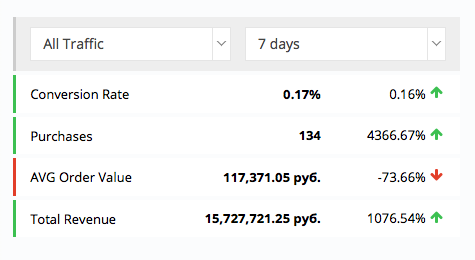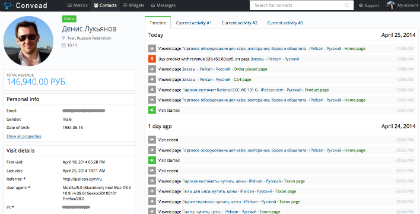How we do Convead: from concept to implementation - part 1
 We sat and
We sat and So we had the idea to make a service that would help online stores to increase conversion in the most simple way for them, not requiring any special alterations to the store itself. And most importantly - that the service itself was extremely simple, with a minimum set of the most important functions.
And what is most important for the store owner? Of course, a good conversion! A low conversion rate is the main headache of the vast majority of online stores. It is for this indicator that marketers and UX-designers are fighting; it is precisely that store owners who are tracking it as a key parameter of efficiency.
Of course, there is still the problem of low attendance, but, unlike conversion, we could not influence it. And the degree of its importance, in the end, still strongly depends on the conversion. Imagine that your little online store is visited by 100 people a day (which is very small), but your conversion is at the level of 30% (it’s not harmful to dream, yeah), which gives you 33 orders a day! Not bad for a small shop with meager attendance?
')
In general, judging in this way, we decided to fight for the conversion! This is how the idea of Convead service was born (short for “Convert your Lead”). Our main idea was to create a service that would allow an online store:
- get to know your visitors and remember them;
- correctly segment them by any signs;
- to see visually how the online store works, where its bottlenecks are, where visitors fall off (both in general and their individual segments);
- influence these segments in one way or another, encouraging them to make a purchase and increasing conversion;
- evaluate the effectiveness of these actions, adjust them if necessary - we called this feature “Analytics And Actions Combined”.
And yet, we have identified the following consumer qualities that the service should have, and for which we decided to strive:
- have a minimum threshold of entry, the most simple setting that does not require special knowledge;
- require a minimum of user time per day; have maximum automation of impacts and clear visualization of key indicators.
So, we decided to focus not on advanced marketers who know how to set up Google Analytics with their eyes closed, and not on programmers who can customize their store as they need, but on the average average owner of a small shop, let's call him Vasya.
Vasya does not have time to delve into complex analytics tools, he is frightened by the words “cohort analysis” and “A / B testing”. He wants to be simply and clearly explained to him: how many people came to him, how many of them fell off, at what stage of the life cycle it happened and what kind of conversion did he have today. And ideally - also press the magic button, so that “everything will be fine”.
I deliberately do not want to go into the description of the competitive advantages of our service over others or compare their functionality. Firstly, we are still only in beta, and there are simply no many functions, and secondly, the article is not about that. In this and the next article, I would just like to describe all the difficulties that we encountered during the development, the technical and organizational decisions we made, to discuss their effectiveness and, perhaps, to get feedback or even some advice.
How we did Convead
 When you start any new project, you always have to find a compromise between your Wishlist and the available resources. At such moments, I always present a picture when a devil sits on one shoulder and whispers in his ear: “We need more functions! Nobody needs a service that can not do anything! Do a cool front, people love the eyes! ", And on the other - the angel, and says:" We are limited in money. It is necessary to test the hypothesis with minimal cost. No one will die if MVP does not export to Excel and somewhere will mimic the layout! ”.
When you start any new project, you always have to find a compromise between your Wishlist and the available resources. At such moments, I always present a picture when a devil sits on one shoulder and whispers in his ear: “We need more functions! Nobody needs a service that can not do anything! Do a cool front, people love the eyes! ", And on the other - the angel, and says:" We are limited in money. It is necessary to test the hypothesis with minimal cost. No one will die if MVP does not export to Excel and somewhere will mimic the layout! ”.We decided to set ourselves a limit of 1.5 - 2 months for the development of a prototype (also known as MVP) and no more. In MVP decided to include only the most minimal necessary:
- gathering information about visitors and visits;
- segmentation and analytics.
Thus, in the current version, Convead is able to collect and analyze information, but is not yet able to influence visitors. Export to Excel, by the way, was done after all, damn it :)
When we conceived Convead, we decided that we would focus on the following business models of websites:
- eCommerce
- SaaS
- Marketplace
- Media
It is assumed that each connected site must indicate on which model it works. Why do I need to describe below. In the current beta version, only the eCommerce model is available.
Each business model assumes a certain life cycle of the visitor on the site. Such a life cycle consists of a set of events that must occur in order for the visitor to achieve the desired result. In simplified form, this life cycle can be represented as a sequential visit to certain pages. We called such pages key pages , as they are key to determining the main indicators of the site’s performance.
The business model for the connected site determines not only the preset set of key pages, but also what indicators we will consider as the main ones, as well as what values of these indicators we will consider “good” or “bad”.
For the eCommerce model, we consider the following key pages:
- Item card (catalog, search, etc. - any meaningful login page)
- Basket
- Checkout
- Confirmation of an order
The scheme of the eCommerce site is presented below:

This scheme with the main indicators is seen by the user at each entry into Convead. For those who read books from the list at the end of the article, this scheme will seem familiar.
The blue circles above show the distribution of incoming traffic:
- Return - those whom we were able to return as a result of this or that impact.
- Paid - paid sources.
- Direct - direct visits.
- Search - visits from search engines.
- Viral - “viral” sources (for the time being, we simply assume that these are only social networks).
Together, these sources make up 100% of your visitors (Visits). The diagram shows how visitors move along our life cycle. At certain stages, they fall off (leave the site) and this serves as a signal to the site owner that something needs to be changed in this part of the site.
The less interest under the red inscriptions on the diagram, the better. Vasya will be easy to understand.
 Next to the scheme there is still a simple table with the main indicators:
Next to the scheme there is still a simple table with the main indicators:- % conversion
- number of purchases
- average check
- total income
Key indicators can be tracked either for all traffic, or for certain segments (about them below), they are compared with indicators of previous periods and the overall dynamics is determined. The tsiferki change not only in the table of main indicators, but also on the life cycle diagram. For example, you can see that, in general, your conversion rates are quite good, but among users with mobile devices there is an extremely high percentage of bounce from the cart page. This may be a signal that something is wrong with this page in the mobile version of the site.
In general, we have big plans for developing the functionality of monitoring and managing the life cycle of the site. For example, if there is a certain amount of representative data, we would like not only to state the fact that you have such a conversion level, but also to compare it with the conversion levels of other stores with similar parameters (subject, regionality, etc.) and to draw conclusions about how current indicators are good or bad relative to industry average.
From here it will be possible to influence the selected segment of visitors through one of the available impact channels, improving the indicators on it. Ideally, we see it this way: if some indicator is “bad”, then Convead will paint this step on the scheme in red and suggest changing the situation for the better by clicking on the “Improve” button and choosing the necessary impact (more on the effects just below).
Current beta features and future plans
Our idea was to give the first version the opportunity to accumulate and analyze data (the passive part), and then teach Convead to produce effects in order to somehow change the situation (the active part) and expand the analytics capabilities.
Therefore, MVP is able so far a little:
- Identify and recognize visitors on the site, display their online activity and remember the history of interaction with the site.
- Count the income from each visitor.
- Segment visitors.
- Display metrics on the main indicators of your site both in all traffic and in the context of segments.
A couple of screenshots of the interface (clickable):
 Visitors list (“With Revenue” segment selected) |  Visitor Card Visitor Card |
Future plans
Impacts
Convead was conceived not only for analytics, but as a tool for actively influencing visitors to the site, but the main feature — effects — was not yet implemented in the current version. We will start doing it as soon as possible.
To begin with, we decided to dwell on the following exposure channels:
- Personalization of the page: widgets, replacement of parts of the page, etc. ("online exposure").
- Email (offline exposure).
The idea is that with the help of offline impacts, we can try to return visitors who have already left the site, and with the help of online impacts - to motivate current active visitors to buy.
All impact channels will support segments so that the impact can be personalized to the maximum.
Possible cases of application of effects:
- Highlight in a separate segment of all visitors who were on the site the last time a week ago, looked at the product page, but did not buy anything. Send them an email "Come back, I'll forgive everything!", Right there on the lifecycle diagram see the% of people who were able to return in this way.
- Create an online impact that will modify h1 on the product page for the visitor we know by entering his name there: “Arkady, well, buy a Philips GC 8620 Iron, please!”.
- Create an online exposure that will show a widget with a promotional code for those visitors who fall into a certain segment (for example, they have a birthday today or they visit the site for the third time, but do not buy anything).
Automated visitor master data collection
There are still a lot of cases for influences, but, of course, the whole idea of targeted impacts is broken on the visitor's inaccessible privacy wall. After all, if he didn’t tell us anything about himself, then we don’t know anything about him, and we can’t realize the most delicious segmentation cases.
In this case, it remains to be content with segmentation by common features: the automatically determined location of the visitor, the number of his visits to the site, the date of the last visit, a visit to certain key pages, etc.
The more data we have, the more flexible we can segment them and the more effectively we can influence them. However, collecting such data is a real headache for shop owners. Our dream is to save them from the need to independently collect data about their visitors. Well, or at least reduce the number of necessary actions to a minimum, passing only the parameters specific to your store.
We continue to think about how to legally collect the maximum amount of data about the user, without complicating either himself or the store owner. Ideally, we would like to see the receipt of all useful for segmentation of data about a person (gender, age, marital status, work, interests, etc.) as automated as possible on the Convead side. Obviously, there are many obstacles to this and of course we know about them. But we have some ideas on this subject and, I hope, we will be able to implement them. If someone has good suggestions on this topic - well in the comments! :)
Integration
Oh, this is the magic word "Integration"! You do not have your own API? Yes, you are the
We thought: why should poor Vasya himself suffer and tune the life cycle of his shop, key pages, ask someone to install a JavaScript snippet, if the vast majority of such Vas use some known platforms or SaaS services? So, Vasya, you don’t have long to suffer - we included in our immediate plans the development of plug-ins for the most common eCommerce solutions.
Improving existing opportunities
We were in a hurry to release the beta version in the timeframe we set, so some comforts still had to be sacrificed.
In the near future we plan:
- improve segmentation capabilities (enable chaining of conditions);
- expand the analytics on Revenue (accept not only the order amount, but also the key parameters - the list of brands or categories of goods in the order);
- add beautiful (and for some stores, unfortunately, not very beautiful) trend graphs of the main indicators.
Conclusion
It so happened that today in the countries of decaying capitalism, the eCommerce market is much more developed than ours, and there are many smart people who write interesting books on the subject of Internet marketing, etc. For example, these books inspired us:
- The Lean Startup: Eric Ries
- Lean Analytics: Use Data to Build a Better Startup Faster (Lean Series) by Alistair Croll
- Advanced Web Metrics with Google Analytics by Brian Clifton
By the way, it will be helpful to read them to any owner of an online store. This, of course, is not a complete list of excellent materials on this topic, I suggest supplementing it in the comments. It will be especially interesting to find out if you think there is something worthwhile on this topic from Russian authors.
For us, this was the first experience of developing such a service, so I want to tell a lot. Unfortunately, it’s difficult to fit everything in one article, so I decided to split the material into two parts.
In the next part (if the current part will be interesting) I will make a story about the difficulties we faced, how we made certain technical and organizational decisions. I will try to give a maximum of tasty technical details using the words Ruby-on-Rails, Postgres, Redis, Sidekiq, JavaScript, table partitioning, load testing , etc. So far, the idea is to state all this in the format of a “description of the problem / situation - a decision made” in order to be able to listen to more experienced comrades and discuss this topic.
In fact, there are still a lot of plans and ideas. Much more than our capabilities. Therefore, I will be very grateful to those who try Convead and vote in our support forum for this or that idea, or offer their own.
From today, the project enters the stage of closed beta testing. You can get access by leaving your email address on the site http://convead.com in the appropriate form.
PS In general, the article should have been published by dlukyanov , as a technical project manager, but he does not have karma for this.
Source: https://habr.com/ru/post/220207/
All Articles